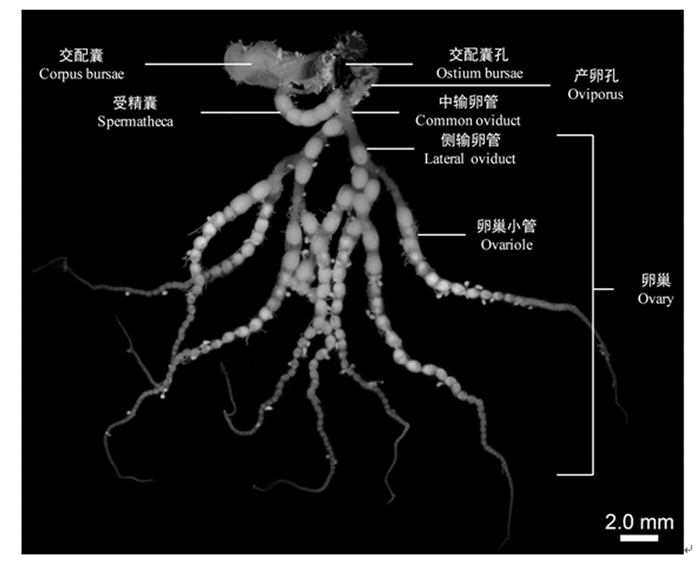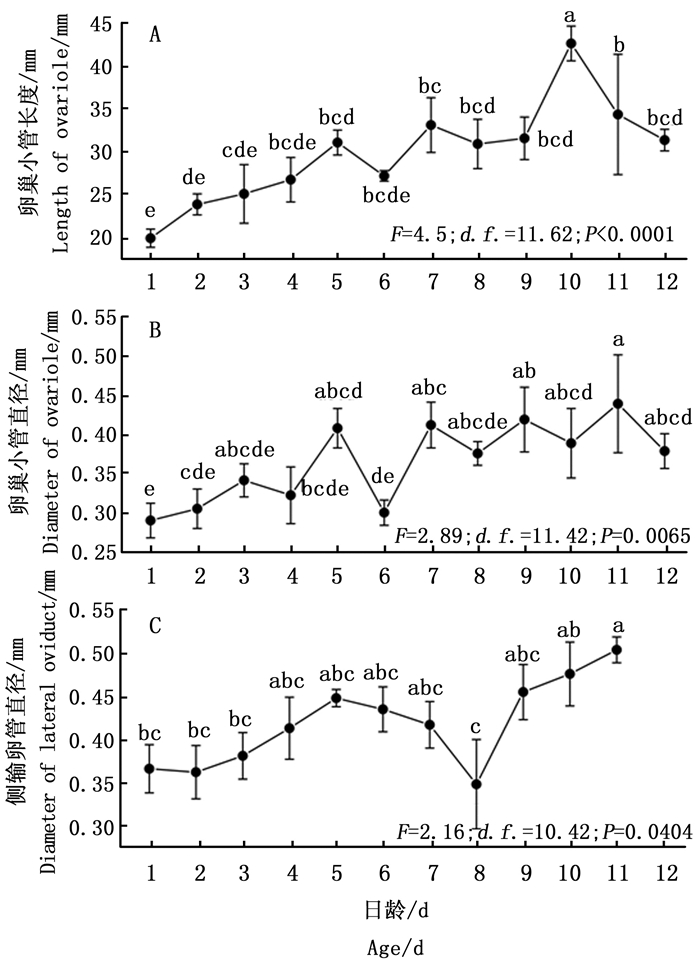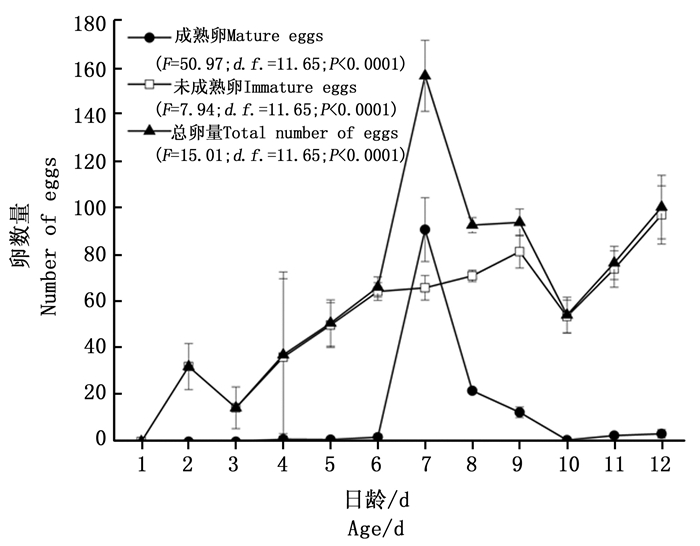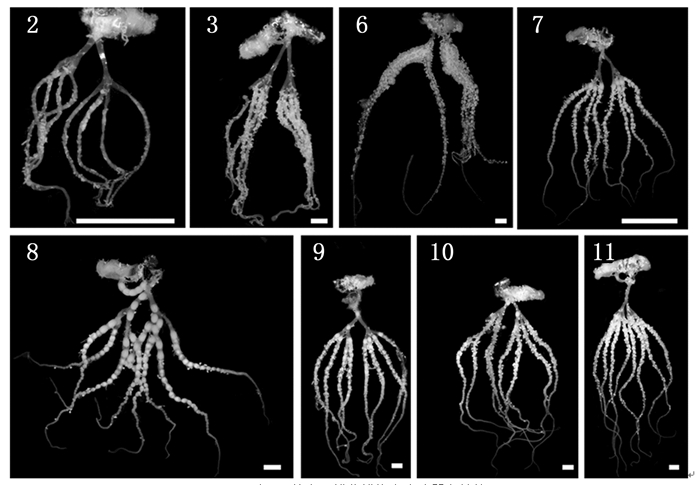-
了解昆虫内生殖器官结构和发育, 有助于深入了解昆虫生殖与繁殖的生物学和生理学, 对分类、行为和化学生态的研究有极其重要的意义。目前关于鳞翅目昆虫蛾类的内生殖器官结构和发育研究比较深入, 蛾类内生殖器官通常是由几部分不同结构组成, 例如, 小菜蛾Plutella xylostella(Linnaeus)雌蛾内生殖系统包含1条受精囊腺、1对附腺、1个受精囊、1对中输卵管、1对侧输卵管、8根卵巢管和1个交配囊[1]。此外, 对于蛾类雌成虫卵巢发育研究亦非常透彻, 通常根据卵巢形态及发育特征、卵的形态及发育特征、脂肪体消耗情况等特征, 将卵巢发育分为5~6级[2-4]。依据其卵巢发育分级, 可以判断稻纵卷叶螟的种群性质, 迁飞型与居留型[4]。对于蝶类, 内生殖系统的发育分级研究较少, 研究主要聚焦于内生殖器官的结构组成。例如, 黄粉蝶亚科的内生殖器包括1对卵巢、2根侧输卵管、1根中输卵管、受精囊、附腺、外生殖腔及产卵孔, 卵巢管8根, 属于多滋式; 外生殖器、包括交配囊及其附属结构、导精管、前后表皮突和腔突; 可通过交配囊、受精囊腺和卵巢等的形态差异来作为不同属间的鉴定特征[5]。另外, 除鳞翅目昆虫外, 半翅目、双翅目、同翅目和鞘翅目昆虫的内生殖器官结构[6-7]与发育[8-12]的相关研究也较多。
综上所述, 目前对于蝶类昆虫仅有关于内生殖器官组成的研究, 尚缺少蝶类雌性卵巢发育过程及分级的研究。因此, 了解蝶类内生殖系统有助于繁殖生理学的研究, 为具有经济价值的蝴蝶的人工繁育与利用提供理论指导。青斑蝶Tirumala limniace(Cramer)属于鳞翅目(Lepidoptera)斑蝶科(Danaidae), 由于其美丽的外观和优美的飞行姿态, 青斑蝶具有较高的观赏价值和经济价值[11]。因此, 成为了节庆放飞、观赏旅游和工艺品制作的优秀品种[12]。规模化养殖是农民实现创收的主要途径之一, 符合农民经济利益。但是目前针对青斑蝶生殖与繁殖的研究较少, 无法为青斑蝶规模化繁殖提供必要的理论参考。本研究通过解剖1~12日龄的青斑蝶雌成虫, 并分别观察和测量了雌性内生殖器官形态和组成结构尺寸, 同时根据各组成结构形态学特征和尺寸大小对雌蝶的卵巢发育进度进行了分级, 以期为青斑蝶的人工培育提供理论依据。
HTML
-
青斑蝶蛹购于昆明中林观赏昆虫科技开发有限公司, 蝴蝶羽化后在实验室饲养(温度26±1 ℃, 相对湿度70%~80%, 光周期L∶D=14∶10)。将蛹悬挂于固定在圆柱形罩网(高: 65 cm, 直径: 50 cm)顶部毛巾上羽化, 以方便其羽化后展翅。羽化后, 雌虫挑出饲养在正方体养虫笼(50 cm×50 cm×50 cm)内, 每天用15%的洋槐蜂蜜喂2次。1~12日龄成虫作为供试虫源。
-
上午9:30将成虫浸泡于40%乙醇中, 使成虫晕厥后, 置于0 ℃蒸馏水中备用。在自制的圆形蜡盘(直径: 15 cm)中倒入0.7%的生理盐水进行虫体的解剖。解剖时将蜡盘置于体视显微镜(Leica MZ16A, Leica有限公司, 德国)的载物台上, 在10×目镜和1×物镜下进行。
-
将雌成虫内生殖器官置于超景深三维显微镜(VHX-1 000, KEYENCE, 日本)载物台下进行拍照采集图片。由于青斑蝶雌成虫内生殖器官尺寸较大, 采集到的是内生殖器官的不同组成结构的局部图片。利用显微镜的实时2D图像合成功能, 在放大20倍的情况下, 将局部图片合成为内生殖器官的完整图片。然后, 利用显微镜自带的XY测量系统, 在合成的完整图片上测量各结构的物理参数(实验测定的各生殖器官大小的样本量与解剖的雌蝶样本量不一致是由于解剖过程部分器官会出现破损的情况, 而对于有破损的器官没有进行测定)。
-
雌成虫内生殖器官测定了卵巢小管长度、卵巢小管中部直径和侧输卵管直径, 不测量出现破损的卵巢小管和侧输卵管, 1~12日龄各参数分别测定的成虫数量见表 1。根据图片, 统计卵巢小管中成熟卵与未成熟卵母细胞数量。成熟卵呈乳白色、表面均匀分布着纵嵴(图 1A); 未成熟卵为卵黄沉积处于50%~100%, (图 1B)。对于卵巢小管出现破损的雌蝶, 不统计卵的数量。由于1日龄并未发现有卵黄沉积, 因此未有1日龄相关统计数据。2~12日龄雌蝶卵巢小管中卵数量分别统计的头数见表 1。
日龄
Age/d雌蝶成虫数量Number of female adult Tirumala limniace 卵巢小管长度
Length of ovariole卵巢小管直径
Diameter of ovariole卵巢内的卵
Number of oocyte in the ovaries侧输卵管直径
Diameter of lateral oviducts1 7 6 — 6 2 8 7 5 8 3 5 3 5 3 4 6 4 6 3 5 8 8 14 7 6 6 3 9 4 7 6 6 5 7 8 8 4 6 4 9 5 4 8 6 10 3 3 3 4 11 4 3 5 3 12 8 3 6 3 Table 1. The sample capacity for measuring the characteristic parameters of female adult Tirumala limniace
-
不同日龄间雌成虫卵巢小管长度与直径、精巢纵轴长与横轴长、以及侧输卵管直径的差异采用One-Way ANOVA进行检验, 当差异达到显著时, 则采用Duncan’s multiple-range test进行检验。不同日龄间雌成虫卵巢小管内未成熟卵和成熟卵数量的差异采用One-Way ANOVA进行检验, 当差异达到显著时, 则采用Duncan’s multiple-range test进行检验。同日龄雌成虫卵巢小管未成熟卵与成熟卵数量间差异, 采用Student’s t test进行检验。所有统计分析均在SAS 9.4中进行。
1.1. 虫源准备
1.2. 内生殖器官解剖方法
1.3. 内生殖器官图片采集
1.4. 内生殖器官特征参数测定
1.5. 数据分析
-
青斑蝶雌成虫的内生殖器官由1对卵巢、1对侧输卵管、1根中输卵管、交配囊腺和受精囊组成(图 2)。卵巢位于腹部3~6节, 左右对称, 每侧由4根多滋式卵巢管组成, 并在基部合并后汇入侧输卵管, 2条侧输卵管在中间合并成中输卵管; 中输卵管粗而直, 沿体中线伸向腹部末端, 开口于生殖腔; 受精囊基部以生殖孔与中输卵管相连接, 端部以输精管与交配囊相连接。卵巢管分为端丝、生殖区、生长区、卵巢管柄4部分。交配囊由近圆形的交配囊孔和中间的表面有凹陷的圆柱体状的海绵组织端部呈透明的半球形。
-
卵巢管长度和直径, 以及侧输卵管的直径均显著受到日龄的影响, 如图 3所示。雌性青斑蝶从1日龄到10日龄, 卵巢管长度随着日龄增长而显著变长, 10日龄时达到最长, 为42.63±2.01 mm, 在10日龄后则显著缩短。卵巢管的直径从1日龄到5日龄缓慢变大, 虽然在6日龄时减小, 但在7~12日龄直径维持在0.35~0.45 mm。侧输卵管直径, 在1~5日龄时缓慢变大, 在5日龄之后直径又缓慢变小, 直至8日龄时的直径最小, 为0.35±0.05 mm, 8日龄后又显著变大, 11日龄时直径达到最大, 为0.50±0.02 mm。
-
雌性青斑蝶在1~6日龄时, 卵巢中成熟卵数量几乎为0, 而7日龄时成熟卵数量增长到最高, 90粒左右, 之后数量又显著降低到10日龄的0.67粒, 11~12日龄维持在一个较低的水平上, 0~3粒。相较于成熟卵, 随着日龄的增长, 青斑蝶卵巢中未成熟卵数量显著增加, 12日龄时数量达到最大, 平均数量为96.7(±12.4)粒。卵巢中卵粒总数量, 在1~7日龄时, 随着日龄增长, 急剧上升, 7日龄达到显著最多, 此时卵总数量为156.0(±15.1)粒, 在7日龄后, 则随着日龄增长显著下降, 下降到10日龄的54(±7.8)粒, 10~12日龄又显著上升, 直至12日龄, 卵总数量显著上升到100.00(±13.6)粒(图 4)。
-
通过对雌蝶1~12日龄内生殖器官解剖(图 5)及卵巢发育分析, 根据卵巢发育特征, 将卵巢分成5个发育等级。

Figure 5. Developmental morphology of internal reproductive organs of 1-to 12-day old female adult Tirumala limniace
Ⅰ级(1~2日, 乳白透明期): 卵巢小管细而短, 卵巢小管柄相对较长。卵巢小管互相缀粘, 无明显卵粒, 部分2日龄出现卵黄沉积现象。脂肪细胞饱满, 乳白色, 圆形或长圆形。
Ⅱ级(3~6日, 卵黄沉积期): 卵巢小管逐渐伸长变粗, 卵巢小管成型沉积(卵室可见), 沉积末期卵黄沉积达到1/2左右。在卵黄沉积的中末期, 卵巢小管柄下端出现亮黄色的卵管塞, 且少数雌虫卵巢有成熟卵粒存在, 卵巢小管间缀粘慢慢降低。脂肪细胞同Ⅰ级卵巢。
Ⅲ级(7~8日, 成熟待产期): 卵巢小管明显变粗, 卵巢小管中开始有较多成熟和近成熟卵粒, 且大多数成虫的卵巢小管柄、侧输卵管、中输卵管和受精囊腺中开始出现或充满成熟卵粒。脂肪细胞变瘪, 卵巢小管相互之间的粘性与Ⅰ级卵巢相比显著降低。
Ⅳ级(9~10日, 产卵盛期): 卵巢小管中成熟卵粒迅速减少, 受精囊腺中堆积有未产出的畸形卵粒, 卵母细胞继续沉积, 卵巢小管中出现空段。部分脂肪细胞呈丝状。
Ⅴ级(11~12日, 产卵末期): 卵巢小管中卵母细胞继续沉积, 有少数卵粒已经成熟, 畸形的卵粒仍然保留在受精囊腺中。丝状脂肪细胞增多。
2.1. 青斑蝶雌蝶内生殖器官
2.2. 雌性青斑蝶成虫的卵巢管长度、直径和侧输卵管直径随日龄的变化
2.3. 1~12日龄青斑蝶雌成虫卵巢管中卵的发育
2.4. 青斑蝶雌蝶卵巢发育分级标准
-
昆虫雌性的内生殖器官通常由1对卵巢小管、附腺、一个或多个受精囊以及连接这些组织的导管组成[13]。青斑蝶雌性内生殖器官组成与之相同, 包括1对卵巢、2根侧输卵管、1根中输卵管、交配囊腺、外生殖腔和产卵孔; 不过, 在青斑蝶雌性内生殖器官中没有发现附腺结构, 这与黄粉蝶和橙黄豆粉蝶雌性内生殖器官结构存在差异[5, 14]。
昆虫卵巢发育与成虫日龄增长相符。对于Polybia occidentalis(Olivier), 工蜂卵巢的发育显著与成虫日龄相关, 较幼嫩的工蜂拥有部分发育成熟的卵巢, 且卵巢的发育随着日龄增长呈指数衰退[15]。本研究结果与前人研究结果相似, 青斑蝶雌成虫卵巢发育与其日龄密切相关。研究指出, 卵母细胞的发育与成熟, 与昆虫成虫日龄密切相关[7]。对于Simulium vittatum(Zetterstedt), 其卵母细胞的发育与成虫羽化后时间的关系近似线性关系[16]。本研究得出, 随着青斑蝶雌成虫日龄增长, 卵巢中成熟卵的数量显著增多, 直至7日龄时达到最大。不过, 卵母细胞随着雌成虫卵巢发育成熟, 会被虫体重新吸收回去, 即卵母细胞再吸收, 例如铜绿蝇Lucilia cuprina(Wied)[17]。青斑蝶雌成虫在7日龄后, 成熟卵粒数量开始显著降低, 直至10~12日龄最低。由于解剖的青斑蝶, 均是处女蝶, 因此, 成熟卵数量降低与卵细胞再吸收有着重要的关系。本研究还发现, 未成熟卵数量随着日龄的增长, 始终缓慢增加。
昆虫卵巢发育分级一般根据各组成结构的形态特征来进行划分, 包括卵巢小管长度和直径、侧输卵管直径、受精囊腺颜色和成熟卵数量等特征, 大多数昆虫卵巢发育被分为5级或6级[2, 4, 9, 18-19]。本研究中, 青斑蝶的卵巢发育分级参考了前人的分级标准, 根据卵巢小管长度、卵巢发育特征、脂肪细胞特点分为了5级。由于青斑蝶雌成虫卵巢小管长度随日龄的变化与卵巢小管直径、侧输卵管直径相比, 显著性更高, 因此本研究将卵巢小管长度进行量化, 纳入了卵巢分级指标, 与前人研究相比, 更形象具体。Ⅰ~Ⅳ级卵巢的卵巢小管呈现变长的趋势, 而Ⅴ级的卵巢小管较于Ⅳ级的卵巢小管变短, 这是说明雌蝶到了V级时寿命已接近尾声, 卵巢开始萎缩。Kuang等[18]根据卵巢小管中卵的发育、卵的消耗、卵巢小管外观和脂肪粒外观, 对欧洲玉米螟Ostrinia nubilalis(Hübner)的卵巢发育分为6级。青斑蝶的发育周期较O. nubilalis短, 所以本研究中只分了5级。
本研究对雌性青斑蝶的内生殖系统结构与发育的研究, 均在恒温恒湿条件下进行。研究指出, 适宜的温湿度及其昆虫的取食对昆虫的卵巢的发育起着至关重要的作用, 温度太高而湿度太低会导致卵巢滞育, 发育停滞不前; 而当昆虫可取食的寄主食物由不可获取变为可以获取时, 同等温湿度条件下滞育卵巢会变成熟[20]。因此, 在实际工作中需要根据不同温湿度来判定具体的卵巢发育进度。
-
雌性青斑蝶的内生殖器官由1对卵巢、1对侧输卵管、1根中输卵管、交配囊腺和受精囊组成; 对卵巢小管长度、卵巢小管和侧输卵管直径测定发现随着日龄增大, 其大小显著变大; 随着日龄的增长, 卵巢中成熟卵的数量先增大后减小, 未成熟卵数量始终缓慢增加; 根据卵巢的发育特征, 将卵巢发育分为乳白透明期、卵黄沉积期、成熟待产期、产卵盛期、产卵末期。本研究将在青斑蝶的人工繁殖中为人为调控雌蝶产卵行为和有效提高其产卵量提供理论依据。

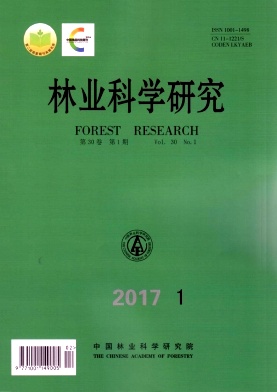


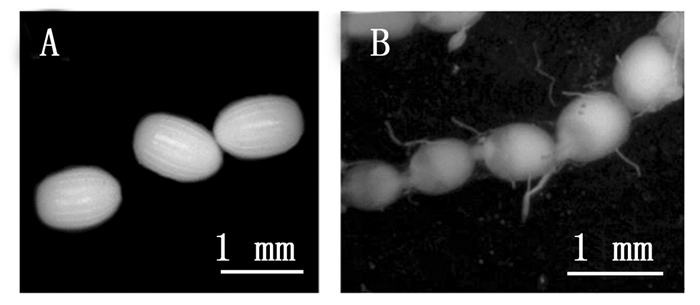





 DownLoad:
DownLoad:
